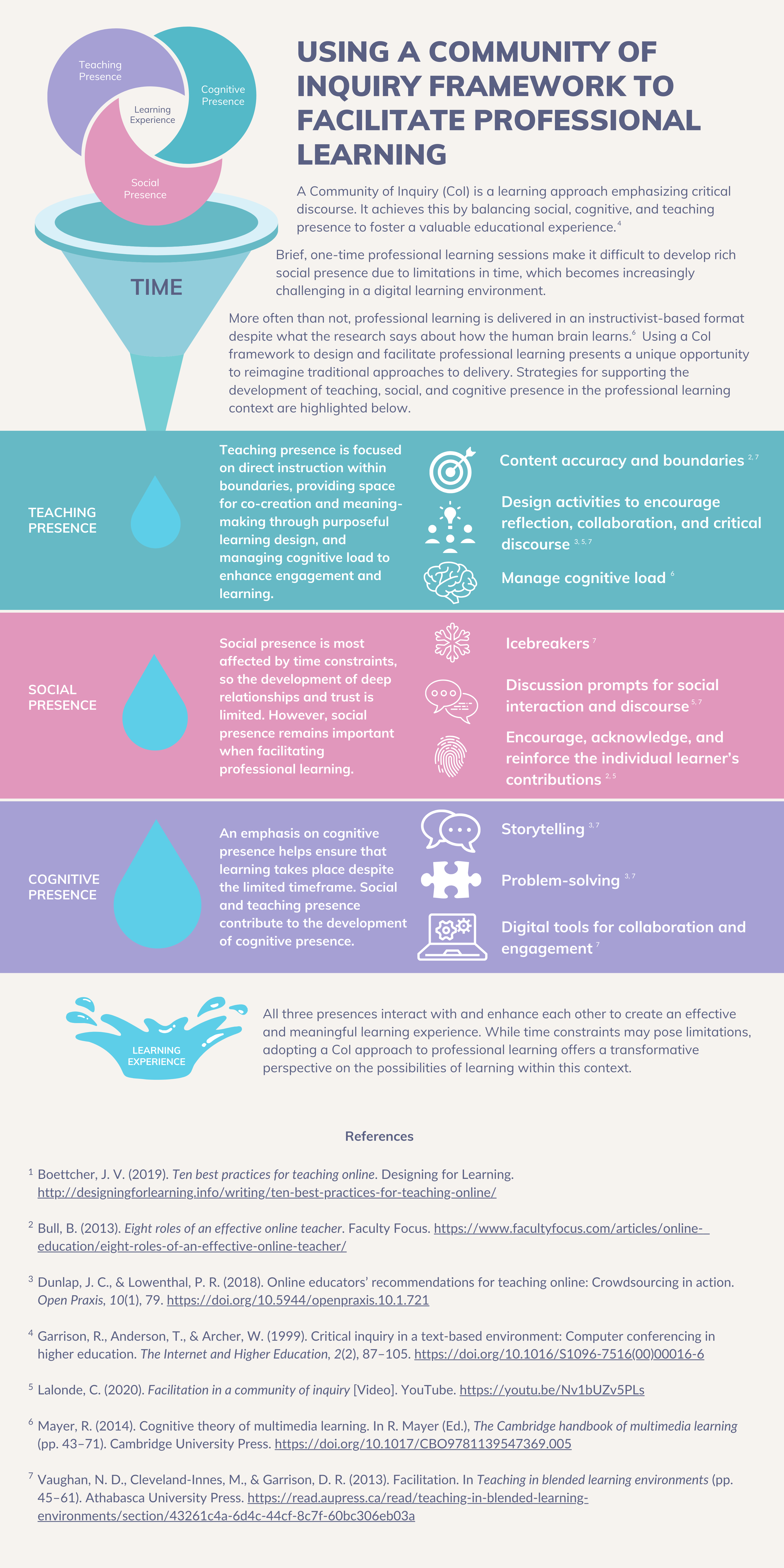
To view this infographic in your browser, click here.
A Community of Inquiry (CoI) is a learning approach emphasizing critical discourse. It achieves this by balancing social, cognitive, and teaching presence to foster a valuable educational experience (Garrison et al., 1999). However, in the context of brief, one-time professional learning sessions, nurturing all three presences can be challenging due to time constraints. According to Garrison et al. (1999), cognitive presence tends to develop more effectively once social presence has been established. Yet, within the limited 60 to 90-minute timeframe of many professional learning sessions, how effectively relationships and trust can be established is questionable. When using a CoI framework to facilitate professional learning, careful consideration must go into the design and subsequent development of all three presences to create an effective and meaningful learning experience. Working within the constraints of time in the context of professional learning, strategies to help social, teaching, and cognitive presence are outlined below.
Teaching Presence
Developing teaching presence includes direct instruction with content accuracy and boundaries (Vaughan et al., 2013) while acting as a valve control, releasing the right amount of information at the right time (Bull, 2013). Further, designing activities to encourage reflection and critical discourse (Lalonde, 2020) supports the co-creation of knowledge, personal meaning, and shared understanding. Lastly, using Mayer’s 12 Principles of Multimedia Learning to inform the design of learning tools such as PowerPoint helps to manage cognitive load (Mayer, 2014) and enhance cognitive presence.
Social Presence
Developing social presence includes the use of ‘icebreakers’ to establish initial social connection and trust between learners (Vaughan et al., 2013). Facilitating discussions allows for social interaction, contributing to a sense of belonging in the learning community while also developing cognitive presence through discourse (Dunlap & Lowenthal, 2018; Lalonde, 2020). Lastly, ecouranging, acknowledging, and reinforcing contributions from the learners can support the expression of identity and a sense of belonging in the learning community (Bull, 2013; Lalonde, 2020).
Cognitive Presence
Developing cognitive presence includes using strategies such as storytelling, where the instructor shares and the learners are encouraged to share stories from their experiences (Dunlap & Lowenthal, 2018; Vaughan et al., 2013). Sharing of experiences opens the door to real-life problem-solving situated in the context of the learners profession (Boettcher 2019; Dunlap & Lowenthal, 2018). Finally, the use of technology and digital tools can make learning more engaging and encourage social interaction (Dunlap & Lowenthal, 2018).
While time constraints may pose limitations, adopting a CoI approach to professional learning offers a transformative perspective on the possibilities of learning and actionable knolwedge within this context.
References
Boettcher, J. V. (2019). Ten best practices for teaching online. Designing for Learning. http://designingforlearning.info/writing/ten-best-practices-for-teaching-online/
Bull, B. (2013). Eight roles of an effective online teacher. Faculty Focus. https://www.facultyfocus.com/articles/online-education/eight-roles-of-an-effective-online-teacher/
Dunlap, J. C., & Lowenthal, P. R. (2018). Online educators’ recommendations for teaching online: Crowdsourcing in action. Open Praxis, 10(1), 79. https://doi.org/10.5944/openpraxis.10.1.721
Garrison, R., Anderson, T., & Archer, W. (1999). Critical inquiry in a text-based environment: Computer conferencing in higher education. The Internet and Higher Education, 2(2), 87–105. https://doi.org/10.1016/S1096-7516(00)00016-6
Lalonde, C. (2020). Facilitation in a community of inquiry [Video]. YouTube. https://youtu.be/Nv1bUZv5PLs
Mayer, R. (2014). Cognitive theory of multimedia learning. In R. Mayer (Ed.), The Cambridge handbook of multimedia learning (pp. 43–71). Cambridge University Press. https://doi.org/10.1017/CBO9781139547369.005
Vaughan, N. D., Cleveland-Innes, M., & Garrison, D. R. (2013). Facilitation. In Teaching in blended learning environments (pp. 45–61). Athabasca University Press. https://read.aupress.ca/read/teaching-in-blended-learning-environments/section/43261c4a-6d4c-44cf-8c7f-60bc306eb03a
